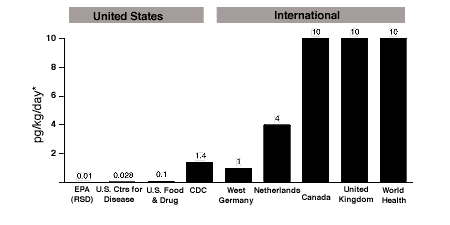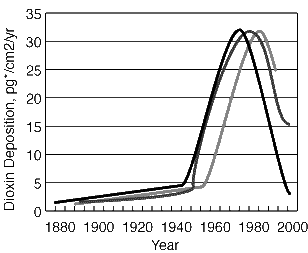Dioxin
and
Health |
What do we know about the health effects of dioxins in the general
population?
Only a few studies have been conducted to evaluate the health effects
of dioxins on the general population. Based on existing information, many
scientists do not expect dioxins at the levels derived from current
sources to cause adverse health effects. In 1994, Dr. Genevieve Matanoski,
a physician and epidemiologist at Johns Hopkins School of Hygiene and
Public Health, noted when analyzing EPA's report on dioxin, "The estimates
of risk state that there may be one cancer caused by dioxin in 10,000
people exposed to the chemical. This number is based on
mathematical models, which deliberately overestimate the risk. At the
other end of the scale, the risk actually could be zero. Again, some
people may be more at risk than others." Matanoski is also chair of an
independent Science Advisory Board (SAB) to EPA that reviewed the agency's
draft dioxin reassessment.
As with any chemical, the potential health effects associated with
dioxins are related directly to the level of exposure: the lower the
exposure, the less likelihood of adverse health effects. Most research
into dioxins' human health effects has focused on people who have received
dioxin doses-through occupational or accidental exposures-as much as
thousands of times higher than the levels that the general population is
estimated to be exposed to from current sources.
What have studies of occupationally and accidentally exposed
populations shown about the health effects of dioxins?
Residents of Seveso, Italy, who were exposed to high levels of dioxins
following an industrial accident in 1976, showed evidence of a skin
disorder known as chloracne and other skin effects, as well as
reversible effects on liver enzyme levels. In fact, in an article
published in American Family Physician, researchers convened by the Agency
for Toxic Substances and Disease Registry (ATSDR) stated that "Chloracne
is the only overt clinical sign of dioxin exposure in humans." ATSDR is a
branch of the U.S. Department of Health and Human Services' Public Health
Service.
Some industrial workers manufacturing chlorophenol or
chlorophenol-based pesticides showed evidence of chloracne and other
skin effects. A few studies of individuals exposed to high levels
of dioxins years ago also have suggested a slight increase in cancer, but
these studies are inconclusive. It is unclear whether that increase was
due to exposure to dioxins, or to other chemicals that were present in the
workplace, or to non-occupational or lifestyle factors, such as smoking.
In addition, other studies of highly exposed populations suggest that
there are other non-cancer health effects from dioxin. Evidence of these
effects, however, is even more uncertain and debated more widely than the
cancer issue.
"Allowable Daily Intake" of Dioxin
The term "allowable daily intake" (or ADI) as used in this figure
refers to the amount of dioxin (expressed in picogram per kilogram of
body weight per day) an individual can be exposed to which is believed
to pose little, if any, risk. This figure presents some examples of an
"ADI" for 2,3,7,8-TCDD as calculated by different scientific
organizations and regulatory agencies around the world. Note that the
"ADI" varies dramatically from country to country and from agency to
agency depending on the differences in the method of calculation. For
example, the World Health Organization's "ADI" value is 1,000 times
greater than EPA's risk-specific dose (RSD) of .01 pg/kg/day. (This RSD
level corresponds to a calculated cancer risk of one in a million.)

| Sources: |
Ahlborg, 1992; Appel, 1986; Dutch State Institute of National
Health, 1982; Kimbrough, 1984; Ontario Ministry of the
Environment, 1985; United Kingdom Department of the Environment,
1989; U.S. Environmental |
Are dioxins present in soil, and if so, do they accumulate in
plants?
Unless there is an obvious source of contamination, concentrations of
dioxins in most soils are quite low.
When dioxins are present in soil, they attach strongly to particles
rich in organic matter. Consequently, dioxins are not easily removed from
soil particles by water percolating through soil, nor are they likely to
move freely in soil. Most studies show that crops or natural vegetation
grown in soils with a known dioxins concentration do not accumulate
dioxins because dioxins bind so tightly to the soil.
Are there dioxins in the air, and if so, can they deposit on plant
surfaces?
Scientists have detected very low levels of dioxins in ambient air.
Although dioxins can break down in the atmosphere, some dioxins will
attach themselves to particulates and eventually settle either in
sediments or soils.
Some evidence suggests that dioxins in the air can collect on the
leaves of plants. Animals that eat these leaves can accumulate dioxin in
their fat. However, scientists consider the direct ingestion of dioxins
which may be present on vegetables and fruits a relatively insignificant
source of current human exposure.
What is being done to reduce dioxins in the environment?
Dioxins continue to receive a great deal of attention from regulatory
authorities around the world. For instance, the U.S. Environmental
Protection Agency is reassessing the risk to human health and the
environment due to exposure to dioxins. After review by its external
Science Advisory Board and extensive public comment, EPA is revising its
initial reassessment document and is expected to release a final draft of
the document in Spring, 1997. In addition, industry and government
research is still being conducted to better understand the way dioxins act
in living systems.
Specific regulations on the operation of combustion facilities will
have a significant impact on the generation of dioxin in the United
States. EPA has promulgated regulations for municipal waste combustion
units and is currently working on promulgating regulations for medical
waste and hazardous waste combustors. These proposed emissions limits are
expected to reduce dioxin emissions from these sources significantly.
The pulp and paper industry, through regulatory compliance and
individual company initiative, has reduced its output of dioxins by more
than 90 percent. The chlorine industry, through its stewardship
efforts, is also working on characterizing and reducing its emissions of
dioxins.
To meet new regulations and help achieve industry stewardship goals,
technologies are being developed to help identify and further reduce the
amount of dioxins released into the environment, as well as to treat
dioxin-containing materials and wastes more effectively. Further
reductions will occur as new technologies are introduced and
implemented.
|


